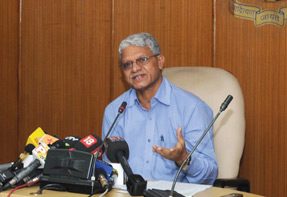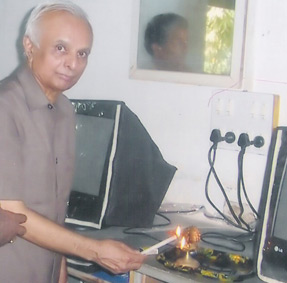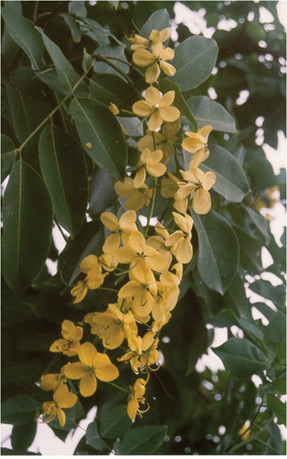Life
I Heard The Crows Call For Rain

As scientific tools falter in predicting rain patterns, Indian scientists turn to the Vedas and traditional knowledge for some fine tuning.
Nearly 70 percent of India’s population relies almost exclusively on agriculture, so accurate weather forecasts are extraordinarily important. During the past 100 years, the monsoon has been normal 85 times, so predicting an uneventful season is relatively safe. Nevertheless, during the last two decades, the official rainbow chasers have gone terribly awry.
Retired Air Vice Marshal Ajit Tyagi, director general of Indian Meteorology Department (IMD), admits, “The extremes are really difficult to forecast.” The 135-year-old department, supported by dedicated satellites and hordes of sophisticated Doppler radars, predict the amount of rainfall (in percentage) annually. Every year, IMD projects precipitation levels on a scale, in which it predicts either a normal monsoon, a drought or a flood. The country’s economic fortunes and rural lives hang on its projections. However, the IMD has failed to predict a single drought in the last 130 years. Throughout the past 20 years, it has predicted only “normal” monsoons, whereas the country experienced floods in 1994 and catastrophic droughts in 1987, 2002, 2004 and 2009. IMD’s projections have proven correct only four times in the last 16 years, representing a failure rate of an astronomical 75 percent. Back to basics
In a country that boasts of being the pioneer in operational seasonal forecasting, such failures can be catastrophic, leaving poor farmers, who are solely dependent on rains for irrigation, stranded. Many turn to folk knowledge, especially Panchang, the traditional Hindu Almanac, which not only explains the religious significance of each day, but also contains the cipher of calculations to accurately foretell rains. Astrologers and pundits have long decoded the Panchang to predict rainfall years. Now Indian scientists are turning the Panchang pages too. Parshotambhai Kanani, a professor at the Gujarat Agricultural University in Junagadh, was one of the earliest scholars to tap the Indigenous Technical Knowledge (ITK) for rain prediction. He researched and published papers on traditional meteorological principles in Saurashtra from 1990-1998. Kanani related how he was drawn to the research. In 1990, IMD predicted a normal monsoon for the nation as a whole. Although the monsoon was indeed normal in the rest of the country, it eluded the region of Saurashtra even in July, setting farmers on edge. Kanani chanced upon two unknown local meteorological experts, Devjibhai Jamod of Jetalsar village, an engine driver with Indian Railways, who recorded meteorological observations daily and predicted rainfall as a hobby, and a farmer and school teacher Jadhavbhai Kathiria of Alidhra village.
Devjibhai was emphatic that there was no possibility of monsoon in the region that year until Aug 15. “If it rains, along with lightning and mild thunder on the second day of Jayestha month, there will be no rain for the next 72 days,” he claimed on the basis of a 12 century text Bhadli. Jadhavbhai made precisely the same prediction. Kanani says, “We were intrigued by their observations and predictions. Their prediction came accurate.” Kanani put out a public appeal for information on local meteorological experts. Hundreds of farmers wrote back. It was the genesis of a grass-root society, which organizes the annual Monsoon Seminar where state farmers gather to share data and figure out the onset of rains for the next year. Kanani, with the Ancient Rain-Prediction Network (ARPN), prepares weather charts targeted at farmers. These agro-climatologists draw upon one invaluable resource — the farmers’ panchang or almanacs, which have been in use since the 4th century BC. Based on folklore, astrology, rituals and ancient literature, the 30-odd panchangs across the country are the closest equivalents to the U.S. Old Farmer’s Almanac. Two of the most-reliable predictors are based on Bhadli’s couplets on wind direction on two specific days: Akshaya Tritya and Holi. Interpretations of the wind direction on these days foretell monsoon, and also diseases, pests, and expected yield of the crop for the season.
Kanani later published a paper linking traditional and scientific knowledge in weather forecasting for a UNESCO World Summit on Sustainable Development in Johannesburg, South Africa, in August 2002. He published another paper, “Everything is Written in the Sky!: Participatory Meteorological Assessment and Prediction Based on Traditional Beliefs and Indicators in Saurashtra,” in Eubios Journal of Asian and International Bioethics. The papers elaborates on how traditional meteorologists use methods and principles developed by eminent astronomers and astrologers, such as Varahmihir (700-800 A.D.), Bhadri (1000-1200 A. D.), the poet Ghagh (1200-1300 A. D.), and Unnad Joshi (1350-1400 A. D.). Technology weds Astrology Anand Agricultural University (AAU) in Gujarat publishes Nakshtra-Charan, a forecast calendar based on planetary positions, which is popular among local farmers. M.C. Varshney, vice chancellor of the university says, “Planetary system obviously influences the gaseous atmosphere of the earth and so the monsoons. Our validation of the forecast indicates accuracy ranging between 40 to 73 percent for various zones across the state”. Similar predictions are published by astro-meteorologist Dhansukh Shah who links the amount of precipitation with Nakshatra, the position of planets. For example, planet Mercury is responsible for bringing rain in Saurashtra while Venus controls rain in Maharashtra, he says. His yearly predictions for the year’s monsoon season are released in April-May. Shah says, “I prefer calling it forecasting of monsoon based on the solar system and not astrology because as soon as you call it that, the brows rise.”
Shah says, “Since 1992, daily positions of the sun, moon and planets are being worked out, and the selected parameters based on relative motion of planets are applied to identify the probable rainy days. From the year 1998 to 2009, the date-wise actual rainfall data was collected and the skill of forecast verified on Yes/No basis. The results are encouraging. Maximum accuracy for one particular year 1999 was 80 percent and average accuracy is more than 67 percent for Saurashtra and Pune.” The IMD, jointly with the Central Research Institute for Dry-land Agriculture (CRIDA), Hyderabad, undertook a pilot project of blending meteorological data with astrological kundalis (horoscopes) to predict rainfall. Earlier, CRIDA had scrutinised the Bio and Astro methods of rain predictions and published a book Indigenous Rain Forecasting in Andhra Pradesh, which validated several folk measures. YS Ramakrishna, then-director of CRIDA and publisher of the book, said that the two expositions by sage Varahamihira — Brahad Samhita and Panchasiddhantika — provide precise details on how to perform the calculations and the principles used in formulating predictions. “Astro-meteorology combined with scientific observations is being proved to be better than mere scientific forecasts. There is an accuracy rate of 60 to 70 percent and there is always a relevance of ancient wisdom for weather forecasting for improving agro-advisories,’’ Ramakrishna says. A number of studies, both field and observation, according to the CRIDA study, validated folk methods of predicting rain. Dr. K Ravi Shankar, a researcher at CRIDA, says, “Even the positioning of the nest by weaver bird was found to be a good indicator of long-range weather forecast in Rangareddy district.” Dr. S.R. Joshi, a well-known astro-meteorologist says: “The basic factors taking part in forecasting rainfall are the same today as they were in the Vedic period. The planets that are moving in the solar system are governed by mutual attractions. Hence, the position of different planets in the solar system indicates the position of clouds.”
Astrologer Ashok Vasudev, head of the J.R. Vedic Trust in New Delhi, says, “Our Vedas say, when the sun goes across star Krittika, the summer heat gets intensified as this star is associated with Sun, the god of fire. That is the exact time phase when temperature keeps soaring and droughts strike. The movement of sun and Saturn in conjunction imply that winters are ahead. Similarly, dry weather prevails when Sun and Jupiter run alongside, while with Venus rainfall is round the corner, so on and so forth. The equations are clear-cut and results sacrosanct.” He adds, “For more than a decade now, I have been predicting rains, floods, droughts and quakes and my forecast rarely go wrong. Meteorology departments’ success rate can’t stand against mine. All credit goes to our ancestors and yogis who wrote these Vedas and Upanishads. I am a mere decoder.” T Unnikrishnan, a Kerala astro-meteorologist who has collaborated with Dr GLHV Prasada Rao of Kerala Agricultural University, says, “The astrological predictions are occurring 99 percent true in Kerala. IMD predicted the onset of monsoon in Kerala from the first week of May to the 31st day of the month, whereas Astro-Meteorology gave dates from 9th of June to 6th of July this year. When I approached IMD they didn’t believe me, when they went wrong, blamed it on El-Niño.” Srikant Jha of Patna’s College of Agriculture says: “All across timeless India, those living off the land are turning to ancient portents rather than relying on a government forecasting machinery that invariably fails them.” He notes wryly, “The Cray Supercomputers with meteorologists cannot match their accuracy.” Jha points out that long before the IMD predicted a drought in Rajasthan, the Bhil tribes of the Thar were already prepared. The extra bushy Khair trees and the wild cucumbers, which had sprouted everywhere, were omen
enough for the villagers. “Other indicators of a dry spell, as followed by village folk elsewhere in India, include crows cawing during the night, foxes appearing during the daytime and snakes climbing up trees. But should chameleons climb trees (besides changing colors to black, white or red) the opposite is indicated — torrential rain,” Jha says. Anil Gupta, a professor at the Centre for Management in Agriculture, Ahmedabad, in scarcely surprised. “After all, what are these indicators? These are recognition of patterns in weather behaviour. Why should the search for patterns not deserve proper scientific scrutiny?” In 1993, prominent Indian meterologist P.R. Pisharoty validated a crucial pattern first outlined in the Brahad Samhita, a 6th Century encyclopedia by Indian astronomer Daivajna Varhamihira, in a paper titled “Plant that Predicts Monsoon” in the Honey Bee journal, in which he councluded that the Amaltas or Golden Shower tree is a uniquely accurate indicator of rain as it bears abundant bunches of golden yellow flowers just 45 days before the onset of monsoon. Says Vasudev: “Modern day compartmentalization of spirituality and science has led us to ignore the age old wisdom of our ancestors. But the ancient combined approach of religion and science could immensely help the society live a better informed life.”
|










You must be logged in to post a comment Login